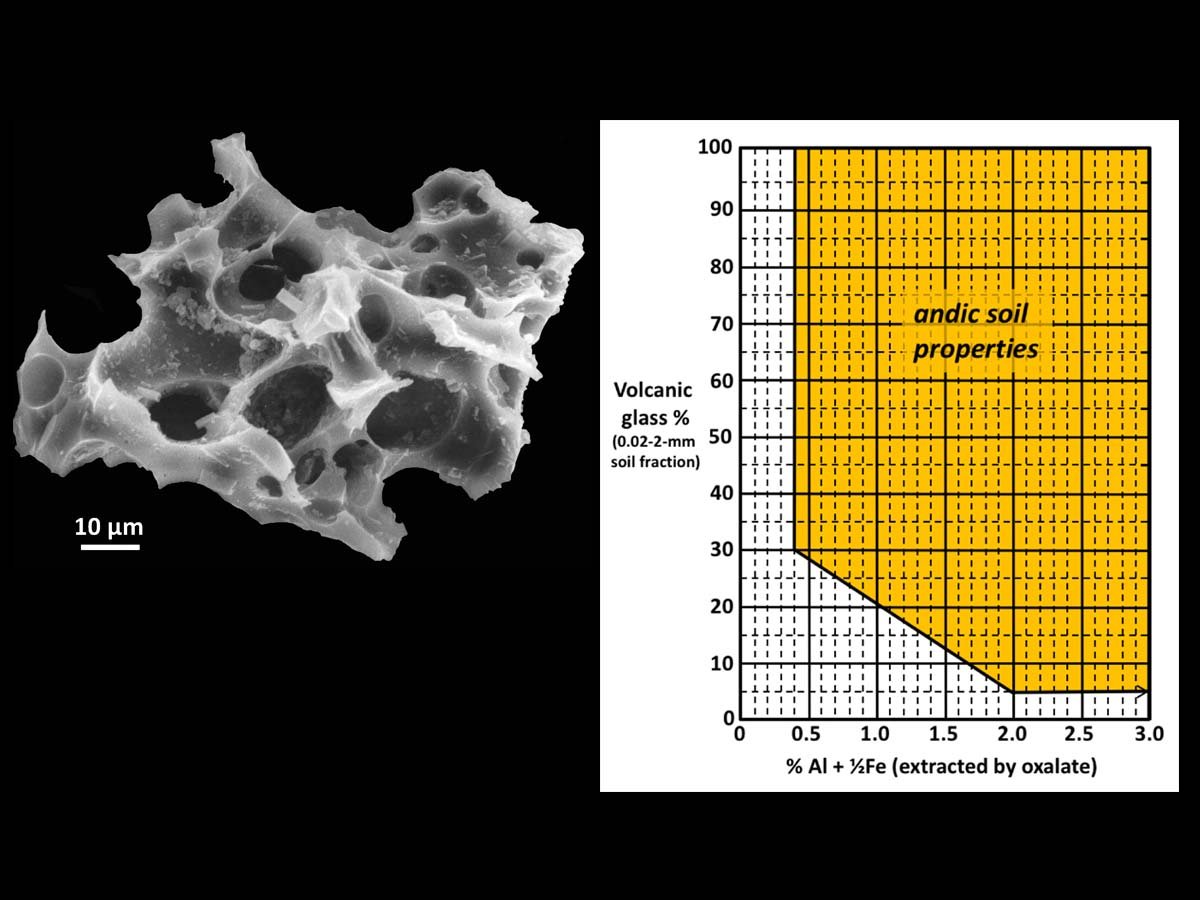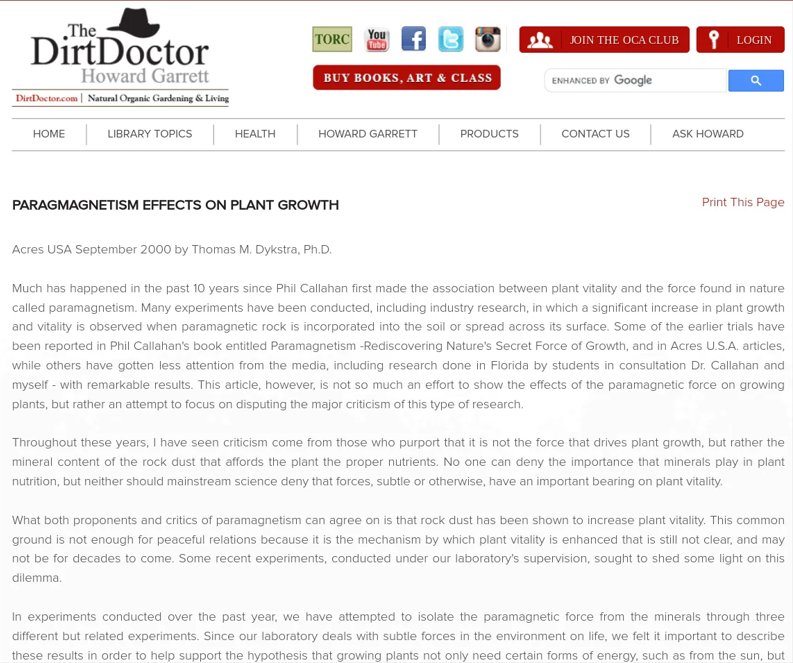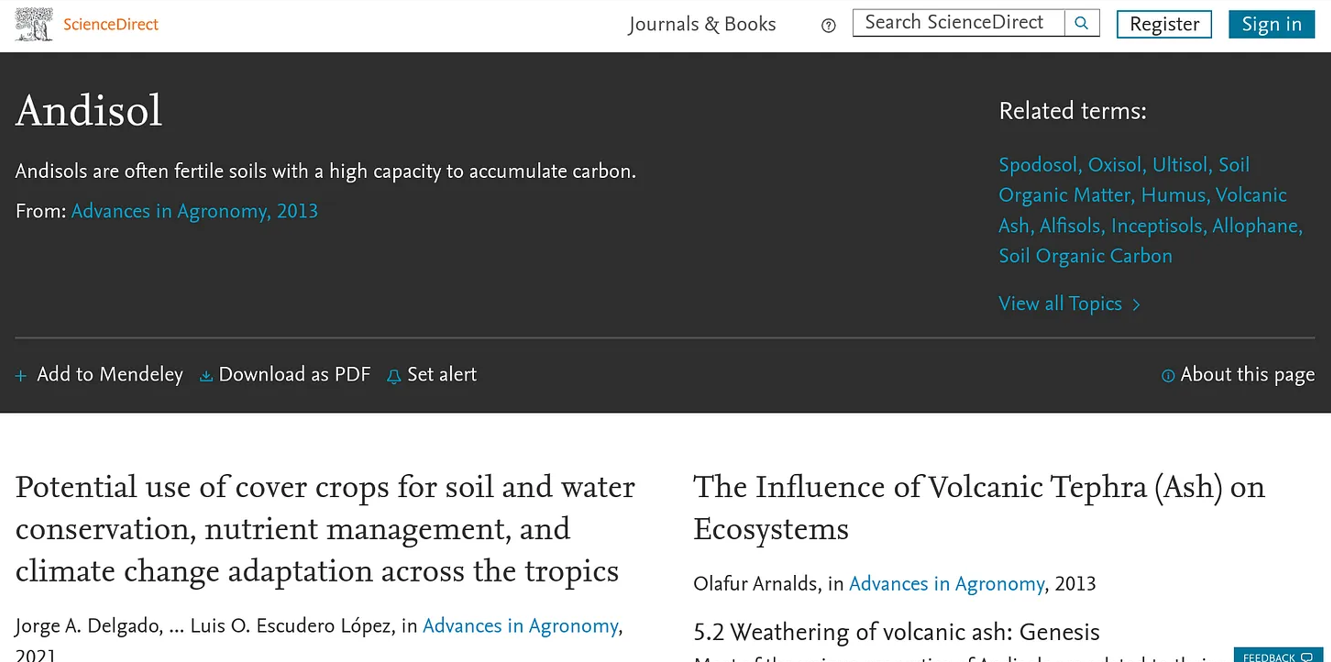Coming Soon
The Extraordinary Benefits of Andic (Volcanic) Soil
Magma*Lite = Basaltic, Volcanic Glass from Tachylite Lava
Most soils derived from volcanic ash and pumice show distinctive properties that are not found in soils derived from other parent materials under the same vegetation and climate. Andisols (from Japanese ando, “black soil”) are soils that have formed in volcanic ash, pumice, cinders, and other volcanic ejecta and are dominated by amorphous volcanic glass and short-range-order colloidal weathering products such as allophane, imogolite and ferrihydrite. These minerals have an exchange complex that is dominated by amorphous compounds of Al, Si, or a matrix dominated by vitrified glass. Bulk densities are always comparatively low in most horizons.
Source, University of Idaho.
Andisols have andic properties — unique chemical and physical properties that include high water-holding capacity and the ability to “fix” (and make unavailable to plants) large quantities of phosphorus and other nutrients. Ando soils consist, primarily, of dark brown to black Al horizons, averaging about 30 cm thick, of fine crumb or granular structure with the organic content close to 8% on average and ranging up to 30% in the darkest members of the group.
More technically speaking, andic soil properties are defined in Soil Taxonomy through a combination of criteria. High volcanic glass content is a common factor. Amorphous glass is slightly reactive, initiating various weathering processes to form Si-, Fe- and Al-containing minerals, including metal-humus complexes (extracted by pyrophosphate), allophane, imogolite and ferrihydrite (quantified using an ammonium oxalate extraction). Together, the percentages of glass and oxalate-extractable Fe and Al are used to define andic properties, which is indicated by orange shading in the figure above. Other criteria used to define andic properties include the ability to retain large quantities of applied P and relatively low bulk density. Source, University of Idaho.
Andisols have andic soil properties in layers either: (1) with a cumulative thickness of 36 cm (14 inches) within 60 cm (23 inches) of the mineral soil surface; or (2) comprising at least 60 percent of the depth between the mineral soil surface and a root-restrictive horizon.
Andic Soils Bind Organic Carbon & Nutrients (phosphorus, magnesium)
Andic soils “contain high amounts of short-range-order and noncrystalline materials, and have low bulk densities. Two short-range-order minerals commonly found in highly leached and weathered Andisols are allophane and imogolite. These minerals have high specific surfaces (approximately equal to 1000 m2g−1) and pH-dependent charge. The high specific surface of the inorganic colloids enables the soil to sequester large quantities of organic matter.” G. Uehara, in Encyclopedia of Soils in the Environment, 2005.
Amorphous Volcanic Glass is the Key
Only certain volcanic materials are high in amorphous glass minerals. The high specific surface of volcanic cinders is a function of the mineral composition of the originating magma, its dissolved gas content, and the specific circumstances of the volcanic activity.
Volcanic glass is the amorphous (uncrystallized) product of rapidly cooling magma. Like all types of glass, it is a state of matter intermediate between the closely packed, highly ordered array of a crystal and the highly disordered array of liquid.[1] Volcanic glass may refer to the interstitial material, or matrix, in an aphanitic (fine-grained) volcanic rock, or to any of several types of vitreous igneous rocks.
Magmas with high dissolved gas content become even more amorphous in their shapes and formations due to the formation of gas bubbles inside the magma. The gas bubbles are referred to as vesicles, and magmas with lots of gas bubbles are referred to as vesicular. Some volcanic materials (pumices) have so many gas bubbles that they float on water.
Magma rapidly cooled to below its normal crystallization temperature becomes a supercooled liquid, and, with further rapid cooling, this becomes an amorphous solid. The change from supercooled liquid to glass occurs at a temperature called the glass transition temperature, which depends on both cooling rate and the amount of water dissolved in the magma. Magma rich in silica and poor in dissolved water is most easily cooled rapidly enough to form volcanic glass
Magma*Lite: Basaltic, Volcanic Glass
Not all magmas are the same. Tachylite describes a specific type of basaltic, volcanic glass formed by the rapid cooling of molten basalt. Basalts by definition are dark in color. The darker the volcanic rock, the less silica (which is white) and the more basaltic. Basalts have low silica content and typically high iron and magnesium content.
Basalt Lava Flow
The basalt sources for Magma*Lite are selectively-mined portions of extraordinarily young basaltic tuff cone volcanic area in Utah—a mere 700 years old.
Basalts that erupt in the open air form three types of volcanic materials: Scoria; Ash (cinder or breccia); and lava flows. Basalt in the tops of open air lava flows and cinder cones will often be highly vesiculated, imparting a lightweight “frothy” texture to the rock. Basaltic cinders are often red, coloured by oxidized iron from weathered iron-rich minerals such as pyroxene.
High Moisture Retention & Organic Matter Binding; Low Density; Micro-Nutrients; Paramagnetic
Magma*Lite is ideal for improving any soil. Andic soils are defined as containing 60% volcanic glass-derived minerals. Magma*Lite is inorganic and does not decay away. In a natural environment, a volcanic deposition layer in the range of 20cm has been proven to be enough to impart andic properties to soils.
Magma*Lite has low density. The more you add to an existing soil, the lower the density of the soil profile. It permanently breaks up heavy soil.
Magma*Lite has a strong affinity for soil carbon—organic matter. The two go hand-in-hand.
“Andisols are often fertile soils with a high capacity to accumulate carbon.”
OlafurArnalds, The Influence of Volcanic Tephra (Ash) on Ecosystems
The very name for andic soils (the Japanese word ando) derives from the dark color of the soil. The color is more from the bound-up soil carbon than from the volcanic material itself. These properties are due to the amorphous (non-crystal) form of the minerals in volcanic glass.
Magma*Lite, in combination with the organic matter it binds to itself, significantly improves the moisture-holding capacity of any soil.
Magma*Lite is high in iron, magnesium, and dozens of other nutrients. These nutrients become bio-available, over time, through proven and well-understood weathering processes. The high mineral content of Magma*Lite is evident from its dark color. Silica is inert and is light in color. Volcanic materials (e.g., rock dusts) that are light in color are, by definition, high in silica and, therefore, low in other minerals. Some “rock dust” products marketed for their alleged micro-nutrient content contain as much as 65-70% silica.
Basaltic Tachylite Lava (glassy, vesicular) is low in silica and is the ideal source for building soils with andic properties.
All basalts are naturally paramagnetic and Magma*Lite is no exception. Richard Mudhar’s blog post provides a good explanation:
A second article on paramagnetism by Thomas M. Dykstra, Ph.D, can be found in the Dirt Doctor’s library, here.
The interest in paramagnetism derives from the 1995 book Paramagnetism: Rediscovering Nature's Secret Force of Growth, written by Phillip S. Callahan, Ph.D. It is still in print and is available, for example, on Amazon:
Given the fact that the most paramagnetic mineral source is volcanic basalt rock dust, I suspect that at least some of the positive effects of paramagnetism may also be attributed to the other attributes of basaltic rock dusts imparting andic properties on soils. The paramagnetism of the material appears to be a synergystic attribute. One commonality in both lines of research is that changing a soil’s paramagnetic properties requires the incorporation of significant volumes of volcanic materials due to dillution. Andic soils require at least 60% volcanic glass content. These two ideas seem consistent with each other. Such high levels of basaltic, volcanic glass in a soil would also improve the paramagnetic attributes of the soil.
Grain Size <2mm
“Tephra” is the collective term for airborne volcanic materials, while ash is restricted to materials <2 mm in grain size. Magma*Lite is processed (crushed and screened) basaltic, volcanic glass from tachylite lava. The fraction that is under 2mm in size is the same particle size as natural volcanic ash. The smaller the particle size, the greater the surface area of any mineral. As tachylite lava is crushed, the thin walls of the vesicles are easily crushed and flake off into fine particles. Magma*Lite is available in various grain sizes, but the <2 mm size seems to be ideal for agronomic applications.
For additional scientific papers addressing andic soils, consider this page from ScienceDirect or simply research terms on Google: Andisol. Volcanic Glass. Paramagnetism. Basaltic Cinder Cones. Weathering of tachylite.















